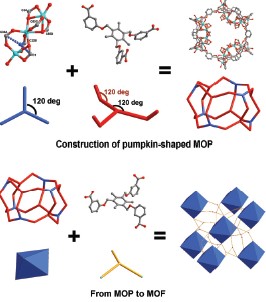| [1] (a) Farrusseng, D.; Aguado, S.; Pinel, C. Angew. Chem., Int. Ed. 2009, 48, 7502; (b) Lin, J.-B.; Xue, W.; Zhang, J.-P.; Chen, X.-M. Chem. Commun. 2011, 47, 926; (c) Cui, Y.; Yue, Y.; Qian, G.; Chen, B. Chem. Rev. 2012, 112, 1126; (d) Zhong, D.; Lu, T. Sci. China Chem. 2011, 54, 1395. [2] Mal, P.; Breiner, B.; Rissanen, K.; Nitschke, J. R. Science 2009, 324, 1697. [3] Perry, J. J.; Perman, J. A.; Zaworotko, M. J. Chem. Soc. Rev. 2009, 38, 1400. [4] (a) Seidel, S. R.; Stang, P. J. Acc. Chem. Res. 2002, 35, 972; (b) Tranchemontagne, D. J.; Ni, Z.; O'Keeffe, M.; Yaghi, O. M. Angew. Chem., Int. Ed. 2008, 47, 5136. [5] (a) Wang, X.-S.; Ma, S.; Forster, P. M.; Yuan, D.; Eckert, J.; López, J. J.; Murphy, B. J.; Parise, J. B.; Zhou, H.-C. Angew. Chem., Int. Ed. 2008, 47, 7263; (b) Zhao, D.; Yuan, D.; Sun, D.; Zhou, H.-C. J. Am. Chem. Soc. 2009, 131, 9186; (c) Farha, O. K.; Özgür Yazayd?n, A.; Eryazici, I.; Malliakas, C. D.; Hauser, B. G.; Kanatzidis, M. G.; Nguyen, S. T.; Snurr, R. Q.; Hupp, J. T. Nat. Chem. 2010, 2, 944; (d) Yan, Y.; Telepeni, I.; Yang, S.; Lin, X.; Kockelmann, W.; Dailly, A.; Blake, A. J.; Lewis, W.; Walker, G. S.; Allan, D. R.; Barnett, S. A.; Champness, N. R.; Schroder, M. J. Am. Chem. Soc. 2010, 132, 4092; (e) Yuan, D.; Zhao, D.; Sun, D.; Zhou, H.-C. Angew. Chem., Int. Ed. 2010, 49, 5357. [6] (a) Perry, J. J.; Kravtsov, V. C.; McManus, G. J.; Zaworotko, M. J. J. Am. Chem. Soc. 2007, 129, 10076; (b) Zou, Y.; Park, M.; Hong, S.; Lah, M. S. Chem. Commun. 2008, 2340; (c) Li, C.; Qiu, W.; Shi, W.; Song, H.; Bai, G.; He, H.; Li, J.; Zaworotko, M. J. CrystEngComm 2012, 14, 1929. [7] (a) Liu, T.-F.; Lü, J.; Guo, Z.; Proserpio, D. M.; Cao, R. Cryst. Growth Des. 2010, 10, 1489; (b) Lin, Z.-J.; Liu, T.-F.; Xu, B.; Han, L.-W.; Huang, Y.-B.; Cao, R. CrystEngComm 2011, 13, 3321; (c) Lin, Z.-J.; Liu, T.-F.; Zhao, X.-L.; Lü, J.; Cao, R. Cryst. Growth Des. 2011, 11, 4284; (d) Liu, T.-F.; Lü, J.; Tian, C.; Cao, M.-N; Lin, Z.; Cao, R. Inorg. Chem. 2011, 50, 2264; (e) Lin, Z.-J.; Liu, T.-F.; Huang, Y.-B.; Lü, J.; Cao, R. Chem.-Eur. J. 2012, 18, 7896. [8] Guo, Z.; Cao, R.; Wang, X.; Li, H.; Yuan, W.; Wang, G.; Wu, H.; Li, J. J. Am. Chem. Soc. 2009, 131, 6894. [9] Liu, T.-F.; Lu, J.; Lin, X.; Cao, R. Chem. Commun. 2010, 46, 8439. [10] (a) Qin, L.; Hu, J.-S.; Li, Y.-Z.; Zheng, H.-G. Cryst. Growth Des. 2011, 11, 3115; (b) Fang, Q. R.; Shi, X.; Wu, G.; Tian, G.; Zhu, G. S.; Li, Y. F.; Wang, L. F.; Wang, C. L.; Chen, Y.; Zhang, Z. D.; Guo, Z.; Shang, T. C.; Cai, X. H.; Qiu, S. L. Acta Chim. Sinica 2002, 60, 2087. (方千荣, 石鑫, 吴刚, 田歌, 朱广山, 李亚峰, 王立锋, 王春雷, 陈悦, 张震东, 郭卓, 商铁存, 蔡晓慧, 裘式纶, 化学学报, 2002, 60, 2087.)[11] Liu, T.; Lu, J.; Shi, L.; Guo, Z.; Cao, R. CrystEngComm 2009, 11, 583. [12] (a) Chen, Y. F.; Lee, J. Y.; Babarao, R.; Li, J. W. J. Phys. Chem. C 2010, 114, 6602; (b) Lin, Z.-J.; Yang, Z.; Liu, T.-F.; Huang, Y.-B.; Cao, R. Inorg. Chem. 2012, 51, 1813. [13] (a) Lan, Y.-Q.; Jiang, H.-L.; Li, S.-L.; Xu, Q. Adv. Mater. 2011, 23, 5015; (b) Qin, J.-S.; Du, D.-Y.; Li, W.-L.; Zhang, J.-P.; Li, S.-L.; Su, Z.-M.; Wang, X.-L.; Xu, Q.; Shao, K.-Z.; Lan, Y.-Q. Chem. Sci. 2012, 3, 2114. [14] (a) Wang, J.-J.; Cao, P.-X.; Gao, L.-J.; Fu, F.; Zhang, M.-L.; Ren, Y.-X.; Hou, X.-Y. Chin. J. Struct. Chem. 2011, 30, 1787; (b) Li, Y. J.; Song, H. H.; Wang, J. Y.; Han, Z. G. Acta Chim. Sinica 2007, 65, 2401. (李亚娟, 宋会花, 王继业, 韩占刚, 化学学报, 2007, 65, 2401.)[15] (a) Allendorf, M. D.; Bauer, C. A.; Bhakta, R. K.; Houk, R. J. T. Chem. Soc. Rev. 2009, 38, 1330; (b) Kang, W.; Deng, Z. P.; Gao, S. Chinese J. Inorg. Chem. 2011, 27, 131. (康伟, 邓兆鹏, 高山, 无机化学学报, 2011, 27, 131.) |
